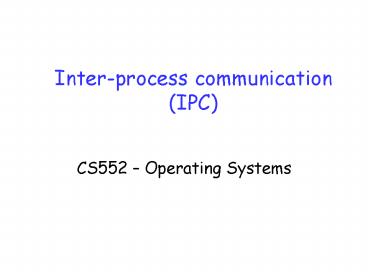Interprocess communication IPC PowerPoint PPT Presentation
1 / 22
Title: Interprocess communication IPC
1
Inter-process communication (IPC)
- CS552 Operating Systems
2
Some simple forms of IPC
- Parent-child
- Command-line arguments,
- wait(), waitpid()
- exit()
- Reading/modifying common files
- Servers commonly use pid file to determine
other active servers. - Pipes
- Uni-directional (if used cleanly)
- ps -aux more
- Can be used bi-directionally with some
synchronization effort
CS552/BU
3
Some more forms of IPC
- Sockets
- Bi-directional
- Not just across the network, but also between
processes. - Signals
- Event notification from one process to another
- Shared Memory
- Common piece of read/write memory.
- Needs synchronization for access
- Semaphores
- Locking and event signaling mechanism between
processes
CS552/BU
4
Pipes
5
Pipe Abstraction
- Write to one end, read from another
- pipe( )
fd1
fd0
Pipe
write( )
read( )
CS552/BU
6
Parent-child communication using pipe
Parent
X
X
Heres an example.
CS552/BU
7
ps aux more
Shell
stdout
stdin
Heres an example.
CS552/BU
8
Being careful with read()/write()
- read(fds0, buf, 6)
- Doesnt mean read will return with 6 bytes of
data! It could be less. Why? - Some reasons
- read() could reach end of input stream (EOF).
- Other endpoint may abruptly close the connection
- read() could return on a signal.
- So you MUST incorporate error handling with every
I/O call (actually with any system call)
CS552/BU
9
Error handling
- More convinient to write a wrapper function
- / Write "n" bytes to a descriptor. /
- ssize_t writen(int fd, const void vptr,
size_t n) - size_t nleft
- size_t nwritten
- const char ptr
- ptr vptr
- nleft n
- while (nleft gt 0)
- if ((nwritten write(fd, ptr,
nleft))lt0) - if (errno EINTR)
- nwritten 0 / call
write() again/ - else return(-1) / error /
- You must
- First check the return value of every
read()/write() system call. - Then either
- Wait to read/write more data OR
- Handle any error conditions
CS552/BU
10
Signals
11
Signals Overview
- Signal is a notification to a process that an
event has occurred. - Could come from another process or from the OS
- Type of event determined by type of signal
- Try listing all signal types using
- kill l
- Some interesting signals
- SIGCHLD, SIGTERM, SIGKILL, SIGSTOP
CS552/BU
12
Handling Signals
- Signals can be caught i.e. an action can be
associated with them - SIGKILL and SIGSTOP cannot be caught.
- Actions to signals can be customized using
- sigaction()
- which associates a signal handler with the
signal. - Default action for most signals is to terminate
the process - Except SIGCHLD and SIGURG are ignored by default.
- Unwanted signals can be ignored
- Except SIGKILL or SIGSTOP
- Heres an example
CS552/BU
13
More on SIGCHLD
- Sent to parent when a child process terminates or
stops. - If act.sa_handler is SIG_IGN
- SIGCHLD will be ignored (default behavior)
- If act.sa_flags is SA_NOCLDSTOP
- SIGCHLD won't be generated when children stop
- act.sa_flags is SA_NOCLDWAIT
- children of the calling process will not be
transformed into zombies when they terminate. - These need to be set in sigaction() before parent
calls fork()
CS552/BU
14
How to avoid zombies?
- Parent could install a signal handler for SIGCHLD
- Call wait()/waitpid()inside the signal handler
- void handle_sigchld(int signo)
- pid_t pid
- int stat
- pid wait(stat)
- printf(child d terminated\n, pid)
- Heres an example.
CS552/BU
15
More information
- Check man sigaction()
- Understand what happens when signal is delivered
in the middle of a system call? - Different OSes have different behavior.
- Google for keywords Unix Signals
- Tons of useful links
CS552/BU
16
- Shared Memory, Semaphores
- Section 15.8 and 15.9 in APUE book
- Man pages shmget, shmat, shmdt, shmctl
- semget, semop, semctl
17
Shared Memory
- Common chunk of read/write memory
- among processes
Proc. 2
Proc. 1
CS552/BU
18
Creating Shared Memory
- int shmget(key_t key, size_t size, int shmflg)
- Example
- key_t key
- int shmid
- key ftok(ltsomefilegt", A)
- shmid shmget(key, 1024, 0644 IPC_CREAT)
- Heres an example.
CS552/BU
19
Attach and DetachShared Memory
- void shmat(int shmid, void shmaddr, int
shmflg) - int shmdt(void shmaddr)
- Example
- key_t key
- int shmid
- char data
- key ftok("ltsomefilegt", A')
- shmid shmget(key, 1024, 0644)
- data shmat(shmid, (void )0, 0)
- shmdt(data)
- Heres an example.
CS552/BU
20
Deleting Shared Memory
- int shmctl(int shmid, int cmd, struct shmid_ds
buf) - shmctl(shmid, IPC_RMID, NULL)
- Example
CS552/BU
21
Command-line IPC control
- ipcs
- Lists all IPC objects owned by the user
- ipcrm
- Removes specific IPC object
CS552/BU
22
References
- Unix man pages
- Advanced Programming in Unix Environment by
Richard Stevens - Chapters 7 to 10, and 14
- http//www.kohala.com/start/apue.html
CS552/BU

